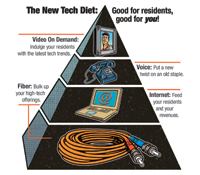And, while setting up wireless might be easy, implementation remains full of obstacles—literally. “We thought it would be simple,” says Greg Hardt, information systems coordinator, at ERC Properties in Fort Smith, Ark., of ERC’s decision to go wireless in selected properties’ management offices. “But a filing cabinet is one of the best [shields] against wireless.”
High-rise buildings and offices with dense walls will run up against the type of interference that may simply render a wireless solution impossible. Getting around those obstacles requires more access points and more powerful transmission capabilities,
Doubts about security have kept BH Management from putting its management offices on a wireless network. “I’m not going to [do that] until I feel better about security,” says Figert. “If you get a disgruntled resident, it could be a problem.”
Still, most executives believe that security has improved with better encryption and other security measures. One of the best safeguards against a network breach is also potentially the most straightforward: Keep corporate and residential networks separate. “You have to separate the two networks,” says Hardt.
Breaking Away
Those owner firms that already have cut the cord, even in a limited fashion, do seem satisfied so far. Although he remains wary of implementing a wireless strategy in the front office, Figert has gotten positive feedback from creating hot spots in common areas like the pool. “So far, it is a roaring success,” he says. “It is an unwritten amenity for the leasing agent to have a resident conveniently out at the pool with a notebook.”
And Hardt points out that a wireless front office offers greater flexibility to visiting executives. “They don’t have to knock employees off their computers,” he explains. “They can just gain access through their own computers.” That’s increasingly important, he says, as “more and more executives travel between properties.”
Whether you blame it on MTV, Starbucks, or, more fairly, on a fast-paced and increasingly mobile society, it seems like everyone these days is unplugged. With a whole new generation sprouting wireless devices such as iPods and cellular phones like electronic appendages, property management firms must understand how wireless solutions will fit into their future plans at residential communities. Today, wireless is an interesting musing, but tomorrow it may be a must-have. “When does an amenity turn into a utility?” asks Figert. “At what point is there an expectation of wireless access?”
– Teri Robinson is a freelance writer in New York.
